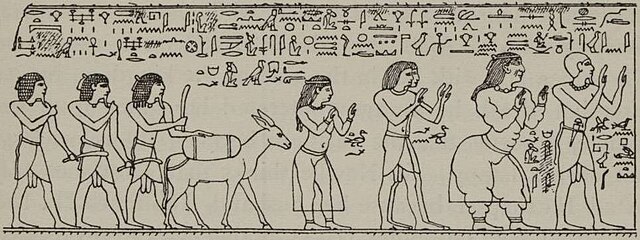The Land of Punt (Egyptian: pwnt; alternate Egyptological readings Pwene(t) ) was an ancient kingdom known from Ancient Egyptian trade records. It produced and exported gold, aromatic resins, blackwood, ebony, ivory and wild animals. Recent evidence locates it in northwestern Eritrea. It is possible that it includes or corresponds to Opone, as later known by the ancient Greeks, while some biblical scholars have identified it with the biblical land of Put or Havilah.
A tree in front of Hatshepsut's temple, claimed to have been brought from Punt by Hatshepsut's Expedition, which is depicted on the Temple walls
Egyptian soldiers from Hatshepsut's expedition to the Land of Punt as depicted from her temple at Deir el-Bahri
This relief depicts incense and myrrh trees obtained by Hatshepsut's expedition to Punt
Image: Pa rehu, the Prince of Punt, his wife and his two sons, and a daughter. (1902) TIMEA
Ancient Egypt was a civilization of ancient Northeast Africa. It was concentrated along the lower reaches of the Nile River, situated in the place that is now the country Egypt. Ancient Egyptian civilization followed prehistoric Egypt and coalesced around 3100 BC with the political unification of Upper and Lower Egypt under Menes. The history of ancient Egypt unfolded as a series of stable kingdoms interspersed by periods of relative instability known as “Intermediate Periods.” The various kingdoms fall into one of three categories: the Old Kingdom of the Early Bronze Age, the Middle Kingdom of the Middle Bronze Age, or the New Kingdom of the Late Bronze Age.
A typical Naqada II jar decorated with gazelles (Predynastic Period)
Early tomb painting from Nekhen, c. 3500 BC, Naqada, possibly Gerzeh, culture
The Narmer Palette depicts the unification of the Two Lands.
The pyramids of Giza are among the most recognizable symbols of ancient Egyptian civilization.








